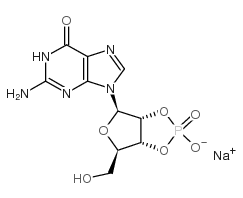2',3'-cGMP sodium

2',3'-cGMP sodium structure
|
Common Name | 2',3'-cGMP sodium | ||
|---|---|---|---|---|
| CAS Number | 15718-49-7 | Molecular Weight | 367.18700 | |
| Density | 2.64g/cm3 | Boiling Point | 778.4ºC at 760mmHg | |
| Molecular Formula | C10H11N5NaO7P | Melting Point | N/A | |
| MSDS | USA | Flash Point | 424.5ºC | |
|
Cyclic di-GMP signalling in the virulence and environmental adaptation of Xanthomonas campestris.
Mol. Microbiol. 63(2) , 429-42, (2007) Cyclic di-GMP is a second messenger with a role in regulation of a range of cellular functions in diverse bacteria including the virulence of pathogens. Cellular levels of cyclic di-GMP are controlled through synthesis, catalysed by the GGDEF protein domain, ... |
|
|
Crystal structure of the ffh and EF-G binding sites in the conserved domain IV of Escherichia coli 4.5S RNA.
Structure 8(5) , 527-40, (2000) Bacterial signal recognition particle (SRP), consisting of 4.5S RNA and Ffh protein, plays an essential role in targeting signal-peptide-containing proteins to the secretory apparatus in the cell membrane. The 4.5S RNA increases the affinity of Ffh for signal... |
|
|
BdlA, a chemotaxis regulator essential for biofilm dispersion in Pseudomonas aeruginosa.
J. Bacteriol. 188(21) , 7335-43, (2006) Multiple environmental cues have been shown to trigger biofilm detachment, the transition from surface-attached, highly organized communities known as biofilms to the motile lifestyle. The goal of this study was to identify a gene product involved in sensing ... |
|
|
Characterization of pKa values and titration shifts in the cytotoxic ribonuclease alpha-sarcin by NMR. Relationship between electrostatic interactions, structure, and catalytic function.
Biochemistry 37(45) , 15865-76, (1998) The electrostatic behavior of titrating groups in alpha-sarcin was investigated using 1H NMR spectroscopy. A total of 209 chemical shift titration curves corresponding to different protons in the molecule were determined over the pH range of 3.0-8.5. Nonlinea... |
|
|
Blocking of DNA synthesis in vitro by a guanosine 2',3'-cyclic phosphate: a possible mechanism of chromosome aberrations induced by U5 snRNA.
Mutat. Res. 326(1) , 71-82, (1995) U5 snRNA can induce both transformation and chromosome aberrations of cells. The polypurine tract, GGAGAGGAA, of the RNA has been suggested to participate in both phenomena. In vitro transcription expected to give this polypurine oligoribonucleotide was assoc... |